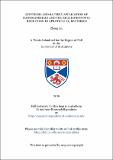Files in this item
Synthesis and battery application of nanomaterials and the mechanism of O₂ reduction in aprotic Li-O₂ batteries
Item metadata
| dc.contributor.advisor | Bruce, Peter G. | |
| dc.contributor.author | Liu, Zheng | |
| dc.date.accessioned | 2018-07-24T14:26:44Z | |
| dc.date.available | 2018-07-24T14:26:44Z | |
| dc.date.issued | 2016-03 | |
| dc.identifier.uri | https://hdl.handle.net/10023/15694 | |
| dc.description.abstract | Hunting for improved energy storage devices based on rechargeable Li-ion batteries and other advanced rechargeable batteries is one of the hottest topics in today’s society. Both Li- ion batteries and Li-O₂ batteries have been studied within the thesis. The research work of this thesis contains two different parts. Part 1. The controlled synthesis of the extreme small sized nanoparticles and their application for Li-ion batteries; Part 2. The study of the O₂ reduction mechanism in Li-O₂ batteries with aprotic electrolytes. In the first part, two different types of extremely small-sized TiO₂ nanoparticles with at lease on dimension less than 3 nm was synthesised via solvothermal/hydrothermal reaction, i.e., anatase nanosheets and TiO₂(B). These nanoparticles were obtained without any contamination of long chain organic surfactants. A series of systematic characterisation methods were employed to analyse the size, phase purity, and surface condition. These extremely small-sized nanoparticles exhibit improved capacity, rate performance as anode materials for Li-ion batteries. The shapes of load curves of charge and discharge are significantly modified due to the reduced size of TiO₂ nanoparticles. In chapter 3, we will see the variation of the capacity and the load curve shape of the anatase nanosheets according to their thickness and surface conditions. The origin of the excessive capacity is analysed based on the electrochemical data. It has been identified that both pseudocapacitive (interfacial) Li+ storage and the excessive Li+ -storage from the bulk contribute to the increased capacity. In chapter 4, the shape and size of the sub-3 nm TiO₂(B) nanoparticles are studied, a method based the PXRD data is established. These nanoparticles demonstrate a reversible capacity of 221 mAh/g at a rate of 600 mA/g and remain 135 mAh/g at 18000 mA/g without significant capacity fading during cycling. In the last part, a systematic study of O₂ reduction mechanism for aprotic Li-O₂ batteries based on the combination of a series of electrochemical and spectroscopic data is presented. The novel mechanism unifies two previous models for the growth of Li₂O₂ during discharge, i.e., Li₂O₂ particle formation in the solution phase and Li₂O₂ film formation on the electrode surface. The new mechanism provides fundamental conceptions for the improvement of Li₂O₂ batteries and shed light on the future research of Li₂O₂ batteries. | en |
| dc.language.iso | en | en_US |
| dc.publisher | University of St Andrews | |
| dc.subject | Lithium ion batteries | en |
| dc.subject | Lithium oxygen batteries | en |
| dc.subject | Electrochemistry | en |
| dc.subject | Nanomaterials | en |
| dc.subject | TiO₂ | |
| dc.subject.lcc | TK2945.L58L5 | |
| dc.subject.lcsh | Lithium ion batteries | en |
| dc.subject.lcsh | Electrochemistry | en |
| dc.subject.lcsh | Nanomaterials | en |
| dc.subject.lcsh | Titanium dioxide | en |
| dc.title | Synthesis and battery application of nanomaterials and the mechanism of O₂ reduction in aprotic Li-O₂ batteries | en_US |
| dc.type | Thesis | en_US |
| dc.contributor.sponsor | Engineering and Physical Sciences Research Council (EPSRC) | en_US |
| dc.contributor.sponsor | SORS | en_US |
| dc.type.qualificationlevel | Doctoral | en_US |
| dc.type.qualificationname | PhD Doctor of Philosophy | en_US |
| dc.publisher.institution | The University of St Andrews | en_US |
This item appears in the following Collection(s)
Items in the St Andrews Research Repository are protected by copyright, with all rights reserved, unless otherwise indicated.

